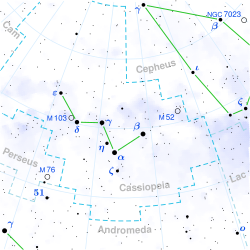Eta Cassiopeiae
| Observation data Epoch J2000 Equinox J2000 |
|
|---|---|
| Constellation | Cassiopeia |
| Right ascension | 00h 49m 06.29070s |
| Declination | +57° 48′ 54.6758″ |
| Apparent magnitude (V) | 3.44/7.51 |
| Characteristics | |
| Spectral type | G0 V + K7 V |
| U−B color index | +0.02/1.03 |
| B−V color index | +0.58/1.39 |
| Variable type | RS CVn? |
| Astrometry | |
| Radial velocity (Rv) | +10.0 ± 0.1 km/s |
| Proper motion (μ) |
RA: 1086.59 mas/yr Dec.: –559.43 mas/yr |
| Parallax (π) | 167.98 ± 0.48mas |
| Distance | 19.42 ± 0.06 ly (5.95 ± 0.02 pc) |
| Absolute magnitude (MV) | 4.57 |
| Orbit | |
| Companion | Eta Cassiopeiae B |
| Period (P) | 480 yr |
| Semi-major axis (a) | 11.9939″ |
| Eccentricity (e) | 0.497 |
| Inclination (i) | 34.76° |
| Longitude of the node (Ω) | 98.42° |
| Periastron epoch (T) | 1889.6 |
|
Argument of periastron (ω) (secondary) |
88.59° |
| Details | |
| η Cas A | |
| Mass | 0.972 ± 0.012 M☉ |
| Radius | 1.0386 ± 0.0038 R☉ |
| Luminosity | 1.2321 ± 0.0074 L☉ |
| Temperature | 5973 ± 8 K |
| Metallicity [Fe/H] | –0.31 dex |
| Rotational velocity (v sin i) | 3.15 km/s |
| Age | 5.4 ± 0.9 Gyr |
| η Cas B | |
| Mass | 0.57 ± 0.07 M☉ |
| Radius | 0.66 R☉ |
| Luminosity | 0.06 L☉ |
| Temperature | 4036 ± 150 K |
| Other designations | |
| Database references | |
| SIMBAD | The system |
| A | |
| B | |
Eta Cassiopeiae (η Cas, η Cassiopeiae) is a star system in the northern circumpolar constellation of Cassiopeia. Based upon parallax measurements, the distance to this system is 19.42 light-years (5.95 parsecs) from Earth.
In Chinese astronomy, η Cassiopeiae is within the Legs mansion, and is part of the 王良 (Wáng Liáng) asterism, named for a famous charioteer during the Spring and Autumn period. The other components are β Cassiopeiae, κ Cassiopeiae, α Cassiopeiae and λ Cassiopeiae. Consequently, η Cassiopeiae itself is known as 王良三 (Wáng Liáng sān, English: the Third Star of Wang Liang.)
The primary star in the Eta Cassiopeiae system has a stellar classification of G0 V, which makes it a G-type main-sequence star like the Sun. It therefore resembles what the Sun might look like were humans to observe it from Eta Cassiopeiae. The star has 97% of the mass of the Sun and 101% of the Sun's radius. It is of apparent magnitude 3.44, radiating 129% of the luminosity of the Sun from its outer envelope at an effective temperature of 6,087 K. It appears to be rotating at a leisurely rate, with a projected rotational velocity of 3.15 km s−1.
...
Wikipedia

